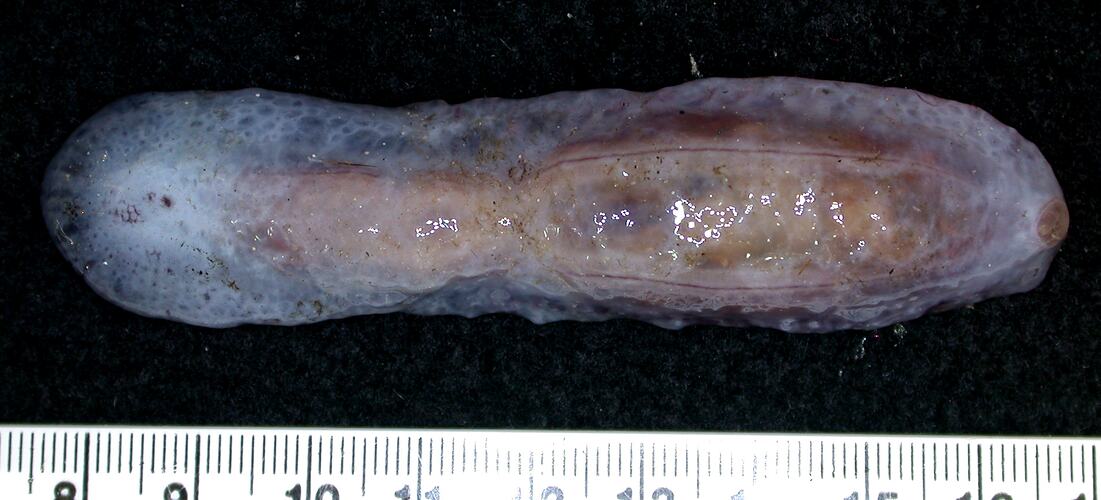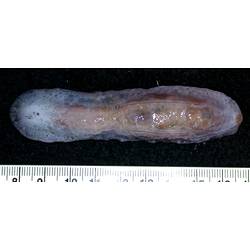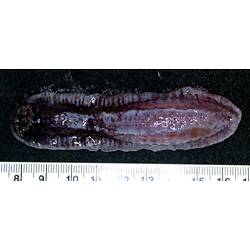General Description
Body soft, gelatinous, elongated, dorsoventrally flattened, slightly convex or arched dorsally; typically purple-violet to red in colour with residual red and darker processes visible in preserved specimens; fused lateral tube-feet create a distinct brim, flattened and wide anteriorly; mouth ventral but not terminal, oral papillae present; anus dorsal and almost terminal; body wall usually thin (can be transparent), pliable; 18-20 tentacles with soft, flattened discs circled by small digitiform processes; brim tube feet in single row, mid-ventral tube feet mixed paired series sometimes grey-black; two scattered bands of retractable dorsal papillae, sometimes only visible as dots, water-vascular canals often visible as dark lines, bare dorsal inter-ambulacrum; ossicles rare spinous rods, but often dissolved or not detected; up to ~35 cm long
Biology
As a benthic deposit feeder Benthodytes sanguinolenta spends most of its adult life crawling along the seafloor feeding on organic particles that have fallen from above. It is also capable of swimming and has been seen doing so in ROV (Remotely Operated underwater Vehicle) footage, e.g. from Ningaloo off the coast off Western Australia. It swims by undulating its widened brim and by flexing its body back and forth. As with most benthic sea cucumbers, adult swimming in Benthodytes sanguinolenta is thought to be facultative - i.e. only used when needed.
Benthodytes sanguinolenta was first collected in 1875 during the historic HMS Challenger expedition from stations at over 2000 m and over 4000 m in the South Pacific Ocean off South America. It has since been found in oceans worldwide, typically at depths of ~700-7000 m on sandy or muddy bottoms. In Australia this species is currently known from the deep sea off Western Australia, Queensland, New South Wales, Victoria, South Australia, and Tasmania.
Distribution
Worldwide at depths of 768-7250 m. In Australia currently recorded from deep sea off Western Australia, Queensland, New South Wales, Victoria, South Australia, and Tasmania.
Habitat
Deep sea marine benthic species occurring worldwide from bathyal to hadal depths (768-7250m).
More Information
-
Animal Type
-
Animal SubType
-
Fast Fact
While these sea cucumbers typically crawl across the sandy bottom of the deep sea, they can swim if necessary, by undulating their velum-like brim and thrusting their bodies back and forth in an almost rolling s-shape.
-
Brief Id
Dorsoventrally flattened body, purple/violet to red in colour, typically 18 tentacles, brim, ventral tube feet.
-
Colours
Purple, Red
-
Maximum Size
35 cm
-
Habitats
-
Diet
Organic matter
-
Endemicity
-
Depths
Deep ( > 30 m)
-
Water Column Locations
On or near seafloor
-
Taxon Name
-
Scientific Author
Théel, 1882
-
Common Name
Sea Cucumber
-
Phylum
-
Class
-
Order
-
Family
-
Genus
-
Species Name
sanguinolenta



